
|   |

|   |
Amrithamahotsav - Chandra Anand e-mail: chandra6267@yahoo.co.in Photos: MM Photography December 16, 2018 'Amrithamahotsav' was an event put up on 31st October 2018 at Sri Shanmukhananda Auditorium, Mumbai, by Dr. Jayashree Rajagopalan, a Bharatanrityam dance guru based in Mumbai. This event was to commemorate her Guru Dr. Padma Subrahmanyam's 75th birthday. Through the event, she depicted a thematic presentation of her guru's life and works. The show commenced with a documentary film on Dr. Padma Subrahmanyam. Turning points and divine experiences that enriched her dance journey were highlighted. Other than that, Jayashree's 50 year-long association with her guru, particularly how she found in her an ideal to follow, were let known in a very subtle manner. Jayashree has also authored a book 'Padma Mandala' which covers her guru's life and all aspects of her research done in subjects of dance, music and literature. After the film, the main presentation of the evening followed. 'Ujjivanam,' a dance drama presentation, depicted the story of a little girl and her intuitive connection with sculptures and their dance, which had been long forgotten. This story was based on Padma's life and in a very succinct manner brought out her mammoth research work on karanas. Karanas is a system of dance movements which are mentioned in the Natya Shastra of Bharata Muni and are frozen in sculptures with inscriptions in temples of South India. But these movements had gone into oblivion as they were not in use any more. It was Padma who interpreted these, revived them, revitalised those movements and brought them back for practice and performance. Thus, 'Ujjivanam - reliving the revival' was an apt title to the presentation. 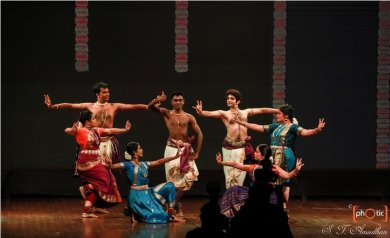
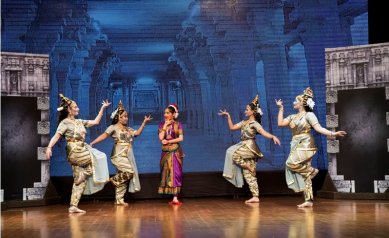
The presentation began with prayers done in the Vazhuvoorar tradition in which Padma was initiated for her Bharatanatyam training. This was followed by the Chitra Purvangam adhering to the format mentioned in Natya Shastra. In the pushpanjali, natis appeared one after another, individually entering the stage and paid their obeisance to Nataraja. An impactful visual treat was beheld in pindibandas with karanas depicting Ganesha on mooshaka and Saraswati on her hamsa. Various poses of Ganesha and Saraswati were held in a sculpturesque manner. The Guru Vandana was depicted in vaakhyartha and padartha abhinaya in a respectful and devout manner. A sutradar, performed by Parimal Phadke, comes in with the jarjara or Indradvaja. The Dvaja Arohana Pooja was done offering prayers in Sanskrit. The five parts of jarjara were attributed to gods Brahma, Hara, Vishnu, Karthikeya and Pannaga. While the sutradar did a simple ritual to the jarjara, these gods were depicted in dance performing relevant pindis. Then, the sutradar and pariparshvakas employ an animated dialogue (trigata) to welcome the audience and tell them why the Amrithamahotsav of Padma Subrahmanyam was being held and brief them about the evening's happenings. A question-answer format of conversation was employed where questions were those which may arise in the mind of the audience. Then the story begins. A pooja is being attended by Padmavati and her family in the Chidambaram temple. The little one, performed by Varshini Harish, is shown around and she is attracted to sculptures in various dance poses and stands mesmerised watching them. She feels they too are watching her. She touches them and they lovingly touch her back, "uyirta shilai ondru uraiththa shilaigalai thotatum uyirthanaI." This special feeling is highlighted by showing her mother perplexed with her daughter's awe and excitement regarding the sculpture as she is unable to see or feel anything for them; they are mere decorations on the wall for her. The setting changes to dance class where Padmavati, a teenager now, performed by Pooja Prasad, is undergoing training in Bharatanatyam. She learns jathiswaram in the class but while practising on her own she involuntarily uses the poses of sculptures that had got imprinted in her mind - "tanjam pugunthana karanangalI." The pose taken by her is highlighted with the relevant photographs of the sculpture on the background screen. Next scene is where Padmavati, her classmates and many others witness a Natyanjali event at the temple. "Natanam adinar" is performed by Srilakshmi Shiva, in Bharatanatyam format, in their presence to much applause. As Padmavati comes out of the temple she is pulled towards sculptures again and wonders if she can know more about them. She emulates their poses. As if having read her mind they come alive and interact with her. She enquires as to who they were. Answering her queries about their history as result of King Chola's dreams, they trace their origin to the nritta of Bharata's time and go on to explain the origin of natya. 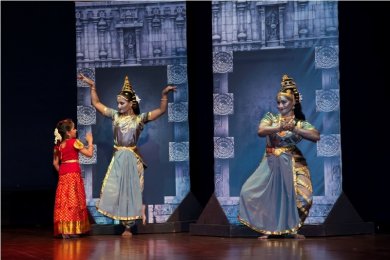
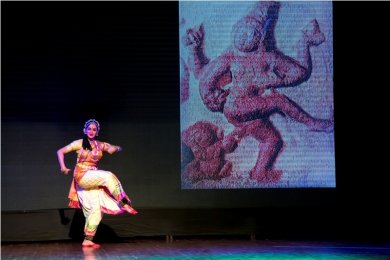
With shlokas from Natya Shastra, the origin of natya was depicted with karanas and various formations. Brahma, performed by Parimal Phadke, is seated in dhyana position. He calls upon each Veda and takes pathya from Rigveda, gana from Samaveda, abhinaya from Yajurveda and rasa from Atharvaveda. Each Veda is represented by a young damsel and they come and sit at his feet. Then, they intermingle making pindis to become the Natyaveda, which due to its benefits of natya utpatti to the performer and viewer is termed as Panchamaveda. Then Bharata receives Natyaveda from Brahma. He is ordered to write and perform a dramatic presentation or natya with his 100 sons. Bharata takes on this task, feels blessed. He mentions, through nritta and abhinaya, the greatness of natya - no art, craft or science is left out in natya. And, also, phalastuthi is stated - one who practises natya achieves bliss. At the end of this scene an angahara equivalent to jati of Bharatanatyam was performed by him. This nritta piece stood like a pearl in the presentation. Bharata's role was performed by Akshaye Ayre, who proved himself to be an excellent Bharatanrityam artist. The next scene starts with Padmavati as a young lady, performed by Aishwarya Harish, entering with sculpture damsels. After recounting their history they tell her that "their story is her story too", they were bonded through karanas - "natanam nam sondham". Perhaps, also, indicating a previous birth when Chola kings, who were great connoisseurs of performing arts, ruled South India. Temple rituals like singing of tevaram and the procession of god in temple prakaras with dancers leading in front were enacted. Then statue damsels disappear into their niches. Now, Padmavati is left alone with more curiosity and verve to know everything about these sculptures. It isn't an easy task. She investigates these dancing images with the help of epigraphical and literary references to know more about each karana. She identifies that these are not simple poses but are frozen moments of movements that have continuity. An example is given with "bhujangatrasitam" to understand the reconstruction of a karana. In fact, the idol of Lord Nataraja is a frozen moment from this karana. Throughout her research she was immensely guided by the divine grace of Mahaperiva of Kanchi. With his blessings she marched forward and fulfilled her yearning to know the story behind the dancing figurines carved in temples, like Brihadeeshwara temple, and their inscriptions. This was shown in visual representation where Mahaperiva held a lotus in hand; juxtaposed was an image of Nataraja statue indicating that she considered herself a mere instrument in his hands for the revival of the art form which has gone into oblivion. The line "Aval udithtal, aval kudittal" in Harini ragam conveys that her task to decipher the secret behind karanas is complete and is rejoicing in her success. She feels enlightened. This piece was enacted bringing in several karanas smoothly going one into the other. Slowly and steadily, the format of Bharatanrityam was formed. In this way the sculptures that are now understood came to life. Conclusion was a happy thillana, in ragam Lalita, talam adi by the whole cast. Different karanas and formations were choreographed in a pleasing manner. At the end, all form the kamalapindi out of which emerges Padmavati. This is to signify from all the hard work and criticism, she rose like a lotus to spread her art throughout the world. Padma Subrahmanyam was indicated by standing with left hand holding alapadma gesture and right hand holding the gesture of shikara on top of the alapadma. On enquiry of why this was used to indicate Padma, the writer was told that on one occasion when Mahaperiva was in mounvrat these were gestures that Mahaperiva used to indicate Padma Subrahmanyam. He held alapadma hasta on his left hand to indicate Padma and held shikarahasta on his right hand to indicate vel and then kept the vel on padma indicating Padma Subrahmanyam. This is as told by the sevaks of Mahaperiva. So this gesture was used. The artists chosen to enact the role of Padmavati - Varshini Harish, Pooja Prasad and Aishwarya Harish - were apt and they did an excellent job. All of them fit into the role of Padmavati very well and one could identify them with Padma Subrahmanyam, especially Aishwarya. She looked very like Dr. Padma when she took those iconic poses. The visuals of Padma Subrahmanyam in those poses were shown on the background screen. Parimal Phadke was out of sync with the dialogue conversation in the Chitra Purvanga part, Akshaye Ayre proved himself an excellent Bharatanrityam dancer and Srilakshmi Shiva gave a splendid performance in "Natanam Adinar". The students of Nrithyodaya Academy of Performing Arts, Mumbai, all participated in the grand event which showed the excellent work carried out by Jayashree Rajagopalan in following her guru's steps. What one could see in this presentation of Bharatanrityam was that this art form has got harmonious character over time. Though this form is supposed to reflect other styles of dance, in this presentation none came to the recall and it stood as a classical medium on its own. Bharatanatyam format was used as and when required by the script as one knows that initially Padma Subrahmanyam trained in Bharatanatyam. The presentation was well supported by Vaishnavi Anand on vocals and nattuvangam and P.V. Harish for vocals, Anantharaman on violin, Aditya Rajagopal on mridangam, flute and keyboard Kumar Krishnan. The concept and choreography was by Jayashree Rajagopalan. The succinct verses in Tamil for the story-line development were written by Isaikavi Ramanan (Chennai). The melodious music for dance drama was set by Vaishnavi Anand (Singapore) and Aditya Rajagopalan. Script and documentary film was by Jayashree Vasudevan (senior most disciple of Jayashree Rajagopalan), Aishwarya Harish (Jayashree Rajagopalan's daughter) and Jyothi Narayanan. Superb set design was by Akshaye Ayre. Apt and inspiring light effects were given by Tanushree Vineet and Mishika Shah. The excellent compering was done by Prof. Gayatri Narayanan of SIES College, Mumbai, and Dr. Rajashree Vasudevan of Shashun Jain College, Chennai. 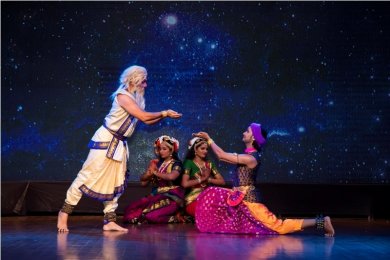
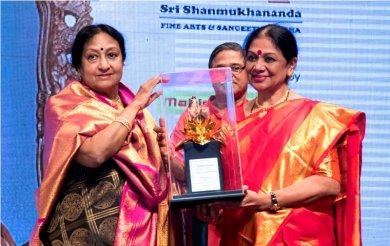 Padma Subrahmanyam & Jayashree Rajagopalan It was very thoughtful of Jayashree to have invited the teachers of ABHAI Mumbai Shakha to give a presentation in Padma's honour. It was during the tenure of Padma Subrahmanyam as ABHAI's president, this Shakha was formed. The ABHAI Mumbai Shaka did a presentation called 'Chanda Soundarya' on the Thirupugazh Chanda Talas. Padma was the one who had identified the similarities between Thirupugazh Talas and Manipuri Talas in early 80s. Further research on the tala systems had been carried out by Jayashree Rajagopalan, with guidance of Padma Subrahmanyam and Darshana Jhaveri. 'Chanda Soundarya' represents the rhythmic patterns which are ingrained in the Thirupugazh that are devotional hymns on Lord Muruga. These hymns were spontaneous outpourings of Arunagirinadhar at various Murugan temples. ABHAI teachers performed three items based on the concept of the Manipuri suddhha taal, shalaga taal and sankeerna taal. They showed padartha abhinaya for verses of Thirupugazh. The songs performed for this event had been identified and rendered by Gayathri Sundaresan, a musicologist. The swaras and jatis interspersing the Thirupugazh was set by Guru Lata Raman - music and Bharatanatyam teacher - for the dance performance. Choreography of dance was also done by Lata Raman with assistance from Anand Satchidanand. These items too were great feast to eyes and ears of the audience. ABHAI artists were well supported by Lata Raman on nattuvangam and vocals, Gayatri Sundaresan on vocals, Anantaraman on violin, Aditya Rajagopal on mridangam and Vijayalakshmi Ramanujam on veena. Though other formal felicitations followed by giving Dr. Padma Subrahmanyam a citation, a unique memento and a purse for BIFAC, the best felicitation surely was the presentation of Ujjivanam that came from the heart of a student to her guru. Chandra Anand is a Bharatanatyam artiste and teacher. She has an MA in Bharatanatyam from Tilak Maharashtra Vidyapeeth, and her series on 'Education in spiritual values through Bharatanatyam' is featured in narthaki.com. |